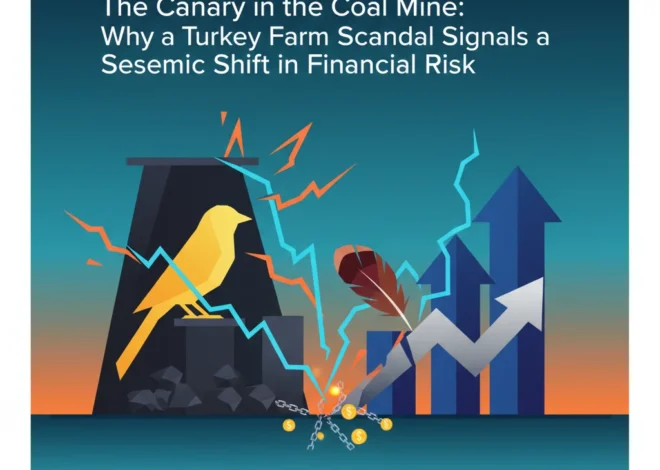
Beyond the Headlines: How New Sewage Spill Fines Are Reshaping the Investment Landscape
In the intricate world of finance and investing, market-moving news often comes from expected sources: central bank announcements, inflation reports, or corporate earnings calls. However, a recent governmental proposal in the UK serves as a stark reminder that significant financial risk—and opportunity—can emerge from the most unexpected of places. The UK government has announced plans to make fining water companies for illegal sewage spills ‘quicker and easier’, a move that seems purely environmental on the surface but sends profound ripples through the stock market, corporate finance, and the broader economy.
For investors, business leaders, and finance professionals, overlooking this development would be a critical error. This isn’t just about environmental protection; it’s a fundamental shift in regulatory risk that directly impacts company valuations, dividend stability, and the very fabric of ESG (Environmental, Social, and Governance) investing. Let’s dive deep into the financial undercurrents of this policy change and explore why a seemingly niche environmental regulation is a major event for the world of finance and economics.
The Regulatory Overhaul: A Closer Look at the New Penalty Framework
At its core, the government’s proposal aims to dismantle the cumbersome and often lengthy process of penalizing water companies for environmental breaches. According to a report from the BBC, the new plans introduce a two-pronged approach: automatic fines for certain offences and a lowered burden of proof for others. This marks a significant departure from the current system, which often involves protracted legal battles and requires the Environment Agency to prove beyond a reasonable doubt that a company caused environmental harm.
The implications of this are substantial. By streamlining the process, the government is signaling a zero-tolerance approach and removing the procedural shields that have historically insulated companies from immediate financial repercussions. To understand the gravity of this shift, let’s compare the old framework with the proposed new one.
Below is a breakdown of the key changes and their direct impact on corporate liability:
| Aspect of Regulation | Previous System | Proposed New System | Financial & Investment Implication |
|---|---|---|---|
| Penalty Mechanism | Lengthy court proceedings, requiring extensive investigation and litigation. | Automatic fines for specific, less severe offences (e.g., failure to self-report). Civil penalties for more serious spills. | Fines become a more predictable, recurring operational cost rather than a rare, exceptional event. This must be factored into financial models and stock valuations. |
| Burden of Proof | Criminal standard: “Beyond a reasonable doubt.” High bar for regulators to meet. | Civil standard: “On the balance of probabilities.” A much lower and easier threshold for regulators to prove. | Dramatically increases the probability of successful enforcement action, escalating the financial risk profile for water utility companies. |
| Speed of Enforcement | Years of investigation and legal challenges could delay penalties. | Fines can be issued more rapidly, impacting quarterly earnings and cash flow almost in real-time. | Reduces a company’s ability to delay and provision for fines over long periods, creating more immediate pressure on liquidity and stock market performance. |
| Source of Fines | Fines paid from company profits, theoretically impacting shareholders. | Fines will be paid into a “Water Restoration Fund,” directly linking pollution to environmental repair. | Increases public and investor scrutiny on how fines are utilized, adding a reputational dimension to the financial penalty. |
This new paradigm transforms environmental transgressions from a potential, distant legal risk into a direct, immediate, and quantifiable financial liability. For anyone involved in trading or investing in utility stocks, the risk calculus has fundamentally changed.
The Point of No Return: Why Climate Tipping Points Are Reshaping Global Finance and Investing
From Balance Sheets to the Stock Market: The Financial Contagion
A fine levied on a multi-billion-pound corporation might seem like a drop in the ocean, but the systemic effects are far more significant. The new policy impacts companies and their investors through several key financial channels:
- Profit & Loss (P&L) Impact: The most direct effect is on the P&L statement. Increased frequency and certainty of fines translate to higher operating costs and reduced net income. For an industry like water utilities, which operates on relatively stable margins, this can be particularly damaging.
- Cash Flow & Dividend Stability: Utility stocks are often prized by investors for their reliable and generous dividend payouts. These dividends are paid from free cash flow. When cash is diverted to pay for a constant stream of fines, the amount available for shareholder returns shrinks. A threat to dividends can cause a significant sell-off in the stock market, as income-focused investors flee. For instance, reports of financial distress at major utilities, often linked to infrastructure costs and fines, have previously sent shockwaves through their stock and bond prices (source).
- Cost of Capital: The banking and bond markets are not oblivious to this heightened risk. A company with a poor environmental record and mounting fines will be seen as a riskier borrower. This leads to higher interest rates on loans and corporate bonds, increasing the company’s cost of capital and further eroding profitability. Financial technology platforms that assess corporate risk are increasingly incorporating real-time ESG data, making it harder for polluters to hide.
- Stranded Assets & CAPEX Demands: The root cause of these spills is aging infrastructure. The new fine regime forces a difficult choice: absorb the continuous financial pain of penalties or undertake massive capital expenditure (CAPEX) to upgrade networks. This investment, while necessary, can depress short-term returns and requires immense funding, potentially leading to new debt or equity issuance that dilutes existing shareholders.
The ESG Imperative: When Environmental Risk Becomes Investment Alpha
This entire episode is a real-world case study in the importance of the ‘E’ in ESG investing. For years, some corners of the financial world dismissed ESG as a “soft” or non-financial consideration. This policy change proves that environmental performance is a hard, material, financial risk.
ESG rating agencies, which are monitored closely by large institutional investors, will undoubtedly downgrade companies that are frequent offenders. A lower ESG score can trigger automatic selling by index-tracking funds and ESG-mandated portfolios, creating significant downward pressure on a company’s stock. According to a leading provider of ESG data, risks like regulatory pressure are a key input into their ratings models. The ability to manage these environmental liabilities is no longer just a matter of corporate social responsibility; it’s a critical component of competent financial management and a driver of stock market performance.
This brings us to the broader economics of the situation. The fines are not just a transfer of money; they represent the internalization of an externality. In economics, a negative externality is a cost imposed on a third party. For decades, the cost of sewage pollution—damaged ecosystems, public health risks, harm to tourism and fishing industries—was borne by society, not the polluter. The new fines force companies to “internalize” this cost, aligning their financial interests with the public’s environmental interests. This is a fundamental principle of modern environmental economics in action.
Beyond the Cap and Gown: Why the UK Graduate Hiring Slump is a Red Flag for the Economy
The Future Horizon: Can Financial Technology and Blockchain Offer a Solution?
Looking ahead, this regulatory shift could spur innovation at the intersection of environmental monitoring and financial technology. The demand for transparent, real-time, and verifiable data on environmental performance has never been higher. This is where emerging technologies could play a transformative role.
- Fintech for Transparency: Imagine fintech platforms that provide investors with real-time alerts on environmental breaches, using data from independent sensors. This would allow for dynamic risk assessment, moving beyond static quarterly reports. Impact investing platforms could also emerge, allowing individuals to directly fund specific infrastructure upgrades with clear, measurable environmental outcomes.
- Blockchain for Trust: One of the biggest challenges in environmental reporting is data integrity. A company self-reporting a spill has an inherent conflict of interest. A blockchain-based system could offer a solution. Data from independent sensors placed along waterways could be recorded on an immutable ledger, creating a tamper-proof record of pollution events. This “trustless” system could be used by regulators to automatically trigger fines and by investors to verify a company’s environmental claims.
While these applications are still developing, the economic and regulatory pressure created by policies like the UK’s new fining system will accelerate their adoption. The future of corporate finance is one where a company’s environmental ledger will be as important as its financial one.
Conclusion: A New Era of Accountability
The UK government’s plan to streamline fines for sewage spills is far more than a piece of environmental legislation. It is a powerful market signal that redefines the financial consequences of pollution. It directly impacts corporate earnings, dividend policies, and stock valuations, turning environmental stewardship into a fiduciary duty to shareholders.
For the general public, it promises cleaner rivers funded by polluters. For business leaders, it is a mandate to invest in sustainable infrastructure or face persistent financial penalties. And for the investment community—from retail traders to institutional fund managers—it serves as a definitive lesson: in the 21st-century economy, you cannot separate a company’s environmental impact from its financial health. The tide has turned, and those who fail to adapt to this new reality risk being swept away by the financial and regulatory currents.
Decoding the Economy: What a Cryptic Crossword Reveals About Modern Finance


